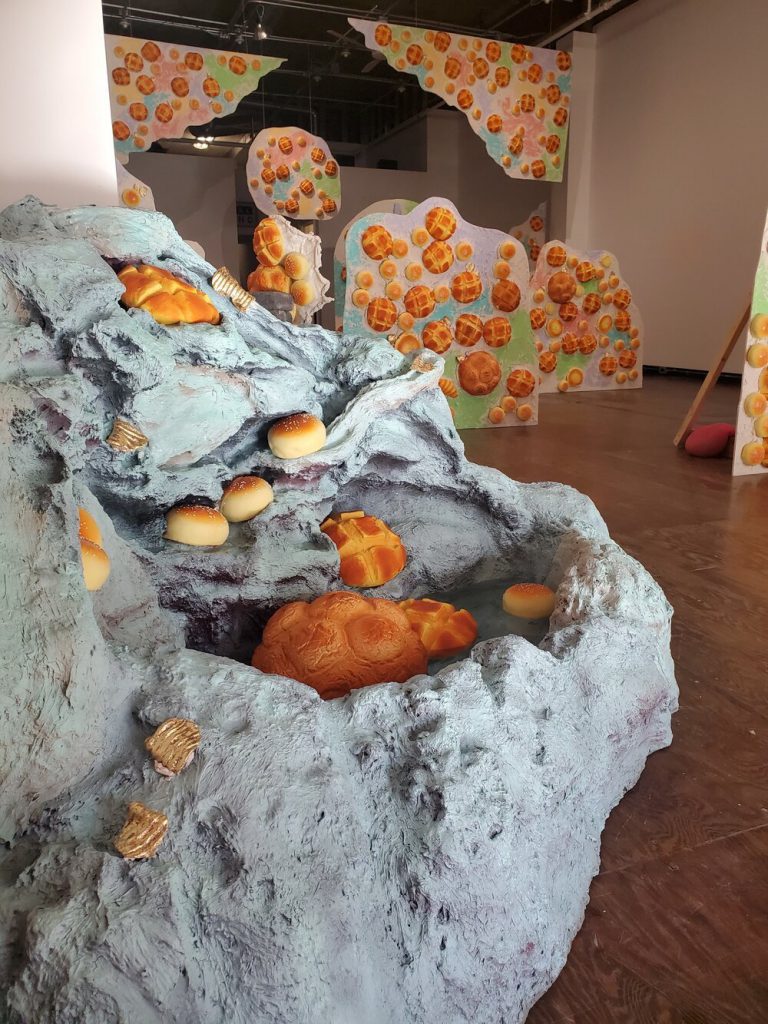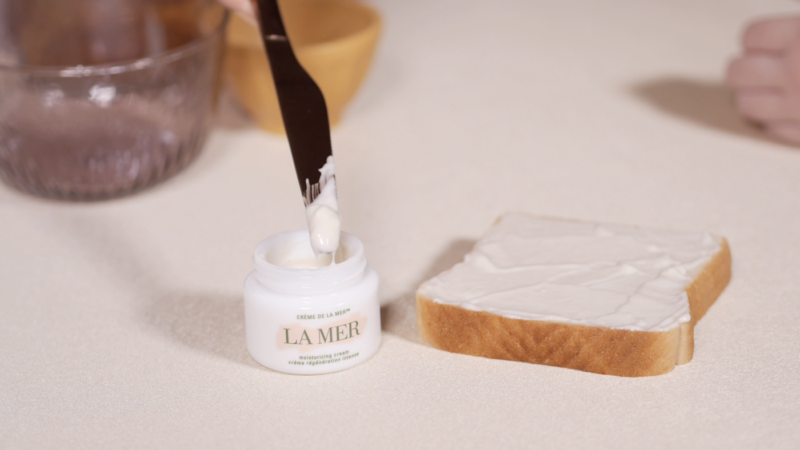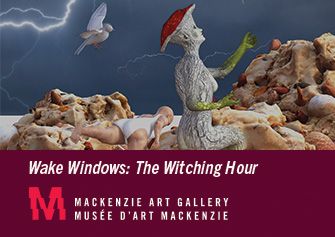Fermentation for the Spirit: Auto-reflections on the rise of sourdough art and glutinous practices. Part 3
26 July 2021
By Lauren Fournier and Greta Hamilton
This essay is the final instalment in a three-part series on culinary fermentation practices and their recent associations in the art world. “Fermentation for the Spirit” considers the rise in popularity of sourdough bread baking during the start of the pandemic, while theorizing on the larger social, political, and cultural potentials of fermentation.
LF: Half a year before the pandemic began, I was aware of a growing trend of sourdough and bread-based practices in contemporary Canadian art—especially art made by late-emerging and early to mid-career women and queer artists, many of whom were white settlers. As boules in art proliferated across a range of gallery spaces, I was curious about what prompted this development. Why were so many white women artists making bread art, and what are the discernible meanings of this shared theme within their disparate practices? Sourdough and bread art can be seen in recent work by artists Andrea Creamer, Bridget Moser, Zoë Schneider, Terri Fidelak, and Lexie Owen, to name a few. There are precursors to this art in work by another artist, Chloe Wise, who began her series of bread bags in 2013, melding challah (braided Jewish bread eaten on ceremonial occasions such as Shabbat and major Jewish holidays), bagels, and pancakes with luxury goods.
Working in Montreal at the time, and later relocating to NYC, Wise created a series of bread purses—high-sheen objects made to look like Chanel and other luxury designer bags. Humorous and playful, the tone of these pieces differs slightly from that of the more recent, prairie-based bread art by Zoë Schneider and Terri Fidelak. I think of artist Lee Henderson’s term “new hoser aesthetics” as a means of understanding the humour in Canadian art, in contrast to American art, wherein the material joys of the former are simpler, more quaint, and less tied to a fast-paced, high-pressure art market that is more prominent in the United States. In much of this bread art, the artists’ gestures share a sensibility that is not unlike “new hoser aesthetics,” which is also inevitably tied to the colonized lands of Western Canada in self-reflexive, often playful ways. Wise’s bread bags, however, are better suited to the American context in which she now lives and works.
Terri Fidelak choreographs performers to butt out their cigarettes into croissants and other pastries as a reflection on hedonistic materialities in the exhibition Pretty, Pretty, Who Needs Flowers?, installed in spring 2020 in the window gallery of Neutral Ground Artist Run Centre in Regina. In her work When There’s Nothing Left to Eat (2019), Andrea Creamer uses sourdough bread cast as bricks to symbolize class war, similarly installed in a window display in Toronto during the summer of 2019, and shown later that fall in Fermenting Feminism at Access Gallery in Vancouver. In Fidelak’s video, the bread is represented as food wasted, with the pillowy end of a cigarette as a metaphor. In Creamer’s sculpture, it is labour and time sacrificed for the purpose of revolution—liberating a society from structural inequity and systemic poverty. Curiously, both works reveal possible ties to French culture: Fidelak’s to stylizations of modern French cinema (La Nouvelle Vague hedonism), and Creamer’s to the French revolution and Jean-Jacques Rousseau’s famous claim that, “When the people shall have nothing more to eat, they will eat the rich.”
Across these artists’ works, bread is a way to symbolize class and the tensions between sustenance, desire, excess, and survival. Creamer cast the bread boule in plaster, coloured with the ruddy red of a brick. The boule as brick, or brick as boule, becomes a potent symbol of revolt. While curating Fermenting Feminism in Vancouver, Creamer and I bonded over our dual lives as both “art people” and frontline social workers/mental health/addictions/anti-poverty advocates with backgrounds working in Vancouver’s Downtown Eastside neighbourhood at different points in history. Access Gallery is located not far from the often sensationalized intersection at Hastings and Main Streets, where the city’s—and indeed the country’s—structural issues of homelessness, poverty, and addiction are concentrated and visible in public space. Creamer and I decided to place her work just close enough to the gallery’s front window to imply the semiotic act of revolution and protest. It was a brick that could be thrown, but wasn’t, symbolizing all of the ferment and foment behind acts of protest.
To look at the brick and feel the intimation of it being thrown invokes a centuries-long historical context, as well as a contemporary one, at a time of increasing polarization and populism, in which the terms “protest” and “riot” have been associated in certain media narratives with those who are racialized and from lower classes, whether that is accurate or not (and, when accurate, these narratives tend to take the protests out of context).2 The boule-bricks next to a single brick, set together on a low table, were a subtle provocation for the viewer to pick one up and throw it through the window. One could imagine what it might feel like to hold that brick-boule in one’s hand. Having some gesture to the boule as brick being thrown through a window was important, even before the Black Lives Matter protests last summer and consequent backlash against looting and rioting (often by white kids from the suburbs, not unlike the 2011 Stanley Cup riots in Vancouver). That the window of the gallery was covered in a vinyl work by Walter Scott—a still from their web-based Xinona—tied the politics of protest to contemporaneous Indigenous issues, like Idle No More and #LandBack.
In spring 2020, Vancouver-based artist Catherine de Montreuil (former Access Gallery staff and graphic designer of Critical Booch), along with David Ng, Laura Gaaysiigad Cuthbert, Jonny Sopotiuk, Jen Sungshine, Ali Bosley, Emily Neufeld, and Zandi Dandizette, successfully co-organized an artist’s union in Canada. One of few such unions in the country’s history, it now operates as the Arts and Cultural Workers Union (ACWU) IATSE Local B-778 in Vancouver, located in Chinatown on the edges of the Downtown Eastside. As a matter of coincidence, Andrea Creamer, herself a former union organizer, tells me that a “bread fund” is union-speak for the emergency fund that members and their families can access in hard times if they are in need of a lump sum. Bread returns again as sustenance for those who are labouring and/or in-need, as something necessary in times of emergency.

As sourdough starters around the world bubbled up in the spring of 2020, Zoë Schneider installed her Our Lady of Sourdough Grotto at the Woodlawn Regional Park in Estevan, Saskatchewan, as an outdoor installation fit for pandemic-safe visits. Functioning like a roadside stop, Schneider sculpted a glowing grotto showing reverence for sourdough bread. It was a campy yet observant gesture to roadside altars one might find in observant Catholic places like postcolonial Latin America or the Philippines. The atmosphere invoked by the grotto reflects bread’s status as comfort food. In the summer, she installed This Grotto Breathes at Neutral Ground in Regina as a larger-scale elaboration on the bread grotto. “Grotto” has etymological ties to the “grotesque,” a word curators and critics use when describing Schneider’s work. While she identifies as a fat artist, she resists these critics’ and curators’ association of fatness with the grotesque. When I look at Schneider’s work, I do not think “grotesque,” but rather “maximalist.” I see a bread grotto, a belly garden, a yeasty fountain; I hear the soothing sounds of water dripping off of puffy epoxy boules, running peacefully past gold-leafed ripple chips; I think of glutinous mermaids basking on a beach.
I’m not sure if Schneider’s baguette pillow is sourdough, but I hope it might be. I project my own bread desires onto the bread sculptures she works with, imagining the baguettes are like the pain fermente I purchased during the summer of 2016 for 1 Euro in Montmartre, one of the best loaves of bread I’ve eaten. The ripple chips tap into some of my earliest memories growing up in the prairies—the haptic sense of Old Dutch chips eaten at the poolside, damp chlorine-soaked fingers softening their edges for a slightly mushy, salty crunch. There’s something uncanny in Schneider’s work in the sense of the familiar being made unfamiliar: carbohydrates often found in kitchen cupboards or snack drawers are now rendered mimetically in inedible material. Bread and baguette mosaics extend down from the ceiling in kitschy frescoes. Like these frescoes, hanging ineluctably from the rafters, Schneider suspends herself above the language of the grotesque, which has historically overdetermined and limited the meanings of her work, creating instead a space to delectably imagine fat mermaids and other beings, both mythical and real.
The exact same baguette body pillow appears in Bridget Moser’s solo exhibition, My Crops Are Dying But My Body Persists, at Remai Modern in Saskatoon in 2020. In her video performance, Moser incorporates a range of white breads into her humorous, conceptual explorations of consumerism and its discontents. The title evokes the idea of being placed, inescapably so, onto a land on which you are dependent for survival. Yet there is a suspension of space and time in the work itself—like being in a non-place, maybe an afterlife, where there is no such thing as pleasure or pain. One has found themselves in a limbo, an environment of numb luxury, waiting for something to shake things up. Here, that something—or someone—is Moser.
In the video, Moser struggles to get comfortable in her own body, amidst the luxuries and privileges surrounding her, wrangling herself onto a mauve velvet divan and spooning up against a body-sized baguette pillow. I reflect on the relationship between Moser, the late-stage capitalist goods she ingests (the most memorable scene consists of Moser eating a slice of white bread meticulously smeared with La Mer face cream), and the sustenance farmer whose sense of identity/self is dying, symbolized by the failing crop and the tirelessly punishing weather. I find myself thinking again about class. Viewing this work in the context of Saskatchewan while living there again at the time, was interesting. Saskatchewan is the home of Tommy Douglas and one of the first wheat pools—the radical socialist and pro-union roots from the early 20th century that the province tends to forget.
The Saskatchewan Wheat Pool is a spectre of a union that once was, but is no longer. These days, the Wheat Pool is an emblem of farmers’ socialism transmogrified into a flailing capitalism, as a result of years of strategic, conservative undoing. The ending of Moser’s video is parodically cathartic, as the performance builds to a climax. In contrast to Schneider’s doughy belly moulds that rest on the floor, Moser wears a commercially-produced skeletal-musculature bodysuit, gesticulating triumphantly to an ultra-slowed-down version of Fun’s “We Are Young” (2011). It’s similar in theme to a song she’s worked with in other videos: Alphaville’s 1984 “Forever Young.” No exception from Moser’s other work, this video is dripping in irony, but doesn’t seem any less sincere.

?
GH: In what I’d like to call the year-long ferment of writing this text, my sense of possibility for social and structural change has altered. At times I have felt that there is potential for a politics of fermentation, a kind of transformation at a microbial level that might resonate infinitely outwards towards systems of food justice, preservation, and sovereignty. I have also felt a longing for more practical and direct change; I have been critical of the limitations of writing about fermentation, or writing about any embodied process as a framework and metaphor for some larger cultural transformation. These fluctuating feelings from excitement to discouragement always lead me back to one question: Can writing be revolutionary? In referencing countercultural movements that birthed mutual aid as we understand it now (though the idea has been around for centuries), and in pointing out the tenuous relationship between art, criticism, and food, I’ve hoped to inspire a revolt against criticism as theory, and theory as inherently limiting. When these various disciplines and thematics are brought together through autobiography and embodied forms, can they sit more deeply in the minds of readers? Can they inspire more potentially revolutionary outcomes? Can writing cause real structural change?
Through this text, I brought up my dad as both a reaction to my surroundings, and to point to the weight his stories hold. My dad’s life carries with it the failures of a countercultural movement—his misogyny pervasive, his racism positing a white settler’s idea of the outdoors, and he carries the shortsightedness of the back-to-the-land movement that perpetuated dated notions of private property and gender-conforming roles. While my dad’s stories contain these harmful histories, he was also my primary caretaker and the person who raised me with a DIY sensibility, a knowledge of gardening and food production, and who instilled in me a sense of reciprocity to land. Baking sourdough together, I thought I might arrive at some answers about my relationship with him, the contradictions of his harm and care. Still it feels like an unthinkable paradox that he should be both harmful and loving, a source of both nourishment and violence, personal and historical. In retelling his stories and thinking about them in a public way, I open up our relationship to the frameworks of critical theory through a more intersectional lens. Retelling his stories is a process of this fermentation, with their impacts bubbling, changing, unravelling, and transforming.
?
LF: Sourdough exists in a tense relationship with Zoë Schneider’s aims as a fat-identified artist committed to fat positivity. Is the boule an offering, a form of nurturance, a way of showing love, or a food one eats purely for comfort? Is it a form of “temptation” tied to the fat body? Schneider emphasizes that “the vilification of certain foods (fat, sugar, and now wheat) is a distraction from building better selves and better communities… I wasted so much time obsessing about food—what I could and couldn’t eat—which was time that could have been spent learning, developing relationships, and growing as a person… In today’s contemporary culture I see the distraction as an orthorexic quest for ‘wellness’ that is thinly-veiled aesthetic homogeneity.”2
It is true that sourdough can be appropriated toward questionable, orthorexic quests, where the souring of dough through fermentation renders bread “permissible” to those watching their weight or living with gluten intolerances, to those on keto diets, all part of an anti-wheat and “anti-carb” tendency taking place in the Zeitgeist. Sourdough, then, takes on an ambivalent status within Schneider’s work, existing in a liminal space that is fundamentally unresolved. I return here to my personal political beliefs that sourdough has the capacity to be mobilized as a tool for the creation of better communities through philosophies of food justice and intersectional access, where body diversity and body positivity are centred over thin-privileged (latently or overtly white) modes, without vilifying thinness. I think we can embrace with ongoing curiosity the possibilities of fermentation as a material practice and a metaphor, including the fermentation of wheat for making sourdough and other breads.
In my year back home in Regina with my parents, there was a gooey lump of sourdough sitting in a clear glass bowl in their kitchen. The dough was autolyzing—the yeasts working their magic, making it so that I, the baker, no longer needed to knead. The sun shone through the window, a weird gift of a warmer few days before the snow blew in and winter arrived with a force, muting everything until the slow thaw of spring. It was a seasonal cycle I am used to, having grown up in the prairies, even as the effects of climate change are felt in startling, cold-hot spurts. There is a note from my journals in these pandemic days, which culminated with my own personal reckonings—my dark night of the soul:
It smells swampy today, the creek having frozen two weeks ago and now thawed, only to freeze again in the coming days. I eat my sourdough with eggs and some raw kimchi sriracha I found at that new market that opened up north of downtown. I’d like to think that healing is possible—that physical, embodied change is possible, from the inside out. I imagine new neural pathways forming, new ways of being in my body, my heart, my brain, taking shape, rerouting…
A lesson I learn from fermentation is that transformation and preservation coexist. You can keep what is working and transform what no longer does; take a step back and see what happens when things start to bubble and fizz.
??
LF & GH: A few weeks into the pandemic lockdown, a meme began trending with an image of actor Donald Glover as his character on the TV show Community, looking ready to start baking sourdough, next to another image of Glover in his music video for “This Is America” from 2018, looking ready to abolish the police. The meme embodies the humour of these rapid changes in left-leaning culture: to go from the happy-go-lucky sourdough baker to the apocalypse-ready revolutionary. Both “trends” were arguably two sides of the same coin, a sweeping need for social change tied to structural concerns, be they food justice or policing and institutional violence. They also came at a time when imagining new systems and structures was (and remains) urgently required. The boule as brick says it all about how mass upheaval can be instigated with a single action—throwing the brick through the window, or keeping the sourdough starter alive. In reflecting on sourdough we are reflecting on the failed systems of late-stage, industrial, globalized capitalism, which have come into sharp focus during the pandemic. Sourdough embodies slowness, spontaneity, patience, rest, support, and a kind of pseudo-domesticity that is always already in excess of “the domestic”—one that aligns itself with a post-neoliberal, post-white-nuclear family future.
In this piece, we have sought to break down the boundaries between art and science, land and life, writing and baking, criticism and fermentation, biology and writing. A knowledge of microbes expands our conceptions of ourselves in relation to others, including but not limited to other humans. We invite questions of metaphysics into those of science, and questions of sovereignty and land repatriation into those of food justice and security. We imagine a world of collaborations with the microbial world, where we get what we need from collectively grown gardens, and from vessels of flour and water that, open to the air around them, take in their environment and transform themselves and others in turn. We write as white settlers living on certain lands in the colonized country some call “Canada,” in bodies that are in the process of healing, entangled with different forms of knowledge, experience, affect, hope, and drive.
We offer fermentation as one possible framework for reimagining the relationships between art, food, and politics, and for collective nourishment—one entry point among many into cultivating an intersectional, decolonial, anti-racist, feminist politics of justice. Looking back to a brief yet hectic flour shortage in spring 2020, a result of the sudden hype around at-home sourdough bread baking in the pandemic’s early days, we ask: What happens if we shift focus in “underground” and “alternative” spaces from self-sufficiency and off-the-grid escape to community sustenance and showing up; when we share boules of bread and recipes with our friends and larger social-microbial networks; when we share knowledge with others, in accessible ways; when we learn and cultivate shared practices of how to keep ourselves and the beings around us alive, thriving, and well? As we write, ferment, and bake, we are imagining, tasting, smelling, touching, reflecting, and feeling toward a more just future.
?
- The people who had thrown bricks through windows here in Vancouver weren’t the economically or structurally disenfranchised, but the upper-middle-class kids from the suburbs who unleashed their boredom and monotonous rage after a hockey game back in 2012, looting stores like H&M. The same trend happened this year with BLM. One anecdote: non-BLM people driving up to stores on Venice Beach, looting, and then hopping back into their cars. When media narratives focus on looting in riots, they distract from the urgent, moral reasons why those who are disenfranchised riot and protest, such as the summer following the public killing of George Floyd, yet another unarmed Black man murdered by American police officers.
- Quote from Zoë Schneider via email, 2019.
Feature image: My Crops Are Dying but My Body Persists, 2020 by Bridget Moser. Video still courtesy of the artist.



